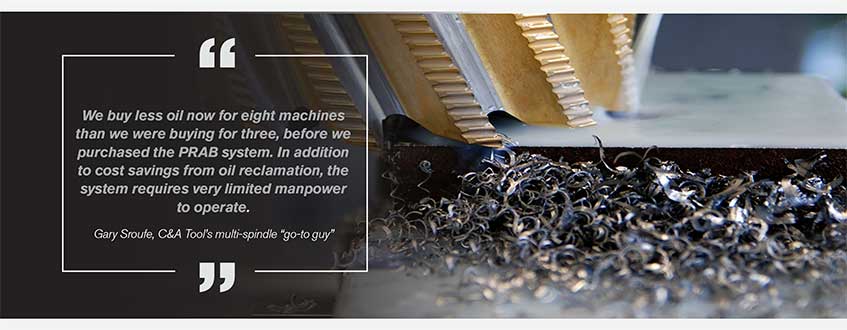A machining supplier needs an automated chip and fluid processing system to process metal turning and chips, while simultaneously capturing expensive cutting fluids for reuse.
C&A Tool Engineering, Inc.
www.catool.com
Machining
Diagonal-Shaft Wringer
Steel Belt Conveyor
Screw Conveyor
Tramp Metal Separator
Vertical Axis Crushers

C&A Tool Engineering, Inc. is a premier international supplier of machining specialties. Over the course of four decades, C&A Tool, directed by owner, Dick Conrow, has grown and honed its capabilities to become the go-to source for the most challenging machining jobs for the transportation, aerospace, defense, medical, industrial and other industries.
From single prototype runs to production volumes in the millions, C&A Tool utilizes 750,000 square feet of precision machining operations in multiple facilities to exceed customer expectations in service and quality.
C&A Tool’s Churubusco, Indiana, facility – known as the South Building – serves as the hub of its operations. Housing state-of-the-art milling, grinding, laser sintering, and turning, in addition to prototyping, metrology and administrative operations, the building employs an “H” shape to facilitate greater efficiencies in servicing eight main work pods.
Everything is designed to maximize our productivity and quality” notes Gary Sroufe, C&A Tool’s multi-spindle ‘go-to’ guy. We take great care to ensure we produce the highest quality product for our customers, and that means having the best people, equipment and facilities.
While its size and capability may be unique, the issues C&A Tool faces relative to waste management are not.
Constructed in 1998, C&A Tool’s South Building initially employed an ineffective, undersized, automatic chip system to process metal turnings and chips.
Our original process was very labor intensive and required constant attention, said Sroufe. It was not effective, far from automatic, and it certainly didn’t fit with our philosophy of having a clean, environmentally-friendly shop.

But when the Index pod expanded from three to eight multispindle lathes to meet growing demand in 2005, it became apparent the current chip and fluid management process could not be sustained.
I was routinely ordering oil because the original process was not effective at capturing the greatest amount of fluid from the chips and turnings,” said Sroufe. “We wanted to take advantage of the latest technology and incorporate it into our process. It only made sense to do to the same for the waste resulting from production.
The reason we purchased PRAB’s equipment is because it can keep up with production, it is fully automatic, clean, and very user friendly. said Sroufe. I used to work in a shop that had PRAB equipment and it ran 24/7, with very little maintenance. When it came time to look at scrap handling systems, I wanted to go with what I felt was the best.
Today, machinists feed the PRAB chip processing system with an average of 15 cubic yards of various steel alloy chips and turnings from eight Index multi-spindle lathes, along with waste from multi-axis Star CNC Swiss-type lathes.
C&A Tool’s chip system is fed by operators who use a forklift to dump 3/4-cubic-yard carts of chips and turnings into a vertical axis crusher. The crusher reduces the metal scrap into flowable chips for further processing. From there, the chips go through a tramp metal separator to ensure no broken tooling or bar ends damage the processing equipment. Then the chips are automatically fed into a diagonal-shaft wringer by a steel belt conveyor. The screw conveyor then dispenses the dry chips into a 1.5 cubic-yard cart. Recovered fluid is held in a custom-designed storage tank for filtering before it is recycled back to the lathes.
“Our original process was very labor intensive and required constant attention. It was not effective, far from automatic, and it certainly didn’t fit with our philosophy of having a clean, environmentally-friendly shop.”
The PRAB system effectively reduces the volume of metal waste by a 6:1 ratio and recovers 99.6 percent of oils, or about 300 gallons (1,135 liters) per day.
We buy less oil now for eight machines than we were buying for three, before we purchased the PRAB system, noted Sroufe. In addition to cost savings from oil reclamation, the system requires very limited manpower to operate.
We were so impressed with the system and the results, we installed a nearly identical system in our Auburn, Indiana facility when we acquired it in 2007, noted C&A Tool vice president, Rob Marr.
• Recovery and reuse of 99.6% of cutting fluid
• Decreased metal scrap volume by a 6:1 ratio
• Reduced labor and improved productivity
• Improved housekeeping